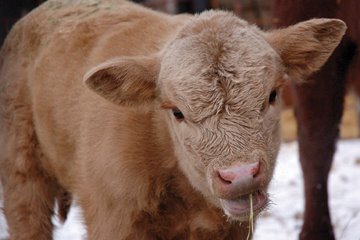
by Brenda Schoepp
n the feeder cattle market centers around the projected loss of inventory in the Canadian beef herd. Analysts are calling for the disappearance of nearly 1M head of beef cows in 2008. The Stats Canada report which will be released June 1, 2009 will put all the speculation to rest, but in the interim, cattle are being bought based on a projected inventory shortage and on the assumption that trade will continue to be liberalized.
In regards to beef cow inventory, we do know that in the United States the herd is back down to a size recorded in the 1950’s. Feedlot capacity is being utilized at a rate just shy of 60% and beef production from fed cattle is projected to decline. Packers have closed, downsized and consolidated at a staggering pace in the past five years. Commercial beef from dairy cows is projected to increase in 2009, but analysts insist this will not be enough to offset the sag in beef supply. Last month, US cattle feeders were suggesting the cow calf industry would need to “give up” some of their profits, but that is unlikely. To ease the pain, US buyers will seek feeder cattle from Mexico and Canada. The majority of Canadian cattle will flow through Saskatchewan, to fill American feedlot pens and kill hooks. Last year US buyers were able to accomplish this with an average basis of (CDN$17.00) cwt. on Canadian feeder cattle.
Feeder cattle exports to the US from the provinces, largely Saskatchewan, Manitoba and British Columbia will continue as long as the export and currency environment allows for it. With a cost of gain on steer calves of $140.00 per head less than last year, Canadian feedlots will also have a deep interest in securing supply. Some are already lining up fall inventory. Does this mean that calf prices will go through the roof – and stay there? Perhaps. First, there is the question of the cow kill vs. cow movement. I am quite certain that more cows and bred females will show up in Saskatchewan, very much alive. And a shortage of supply does not always mean a shortage of beef. As cost of gain decreases, cattle are historically held to heavier weights, thus producing more beef. As well, a shortage of supply only enhances prices for the long term if there is a continued or increased demand. There has not been enough demand to support beef value and beef value has declined for the past three years.
- Brenda Schoepp is a market analyst who ranches near Rimbey, Alberta.


1 comment:
With a Feed Lot and Packing Industry that has been determined to destroy the cow - calf sector. The shortage of feeder cattle will be the ultimate result. The cow -calf sector would like to transform from a "price taker" to a "price setter". But with only two buyers (who will only pay the minimum price so they can maximize their profit)the cow calf sector is doomed.
Who in their right mind would invest in an industry that is controlled by a group of two Who will bankrupt you in a heartbeat so they can satisify their corporate adgenda.
The cattle game is going to go thru a big change... they have killed the "Goose that Lays the Golden Eggs". I do not think the "Idustry" has realized that yet.
I beleive that the cattle numbers are flawed ... I think there is less supply than they are projecting. Think back to when the last time the government numbers were even half accurate.
The producers that have been pushed out of the market place are not coming back.
Welcome to the world of the seven dollar hamburger.
Post a Comment